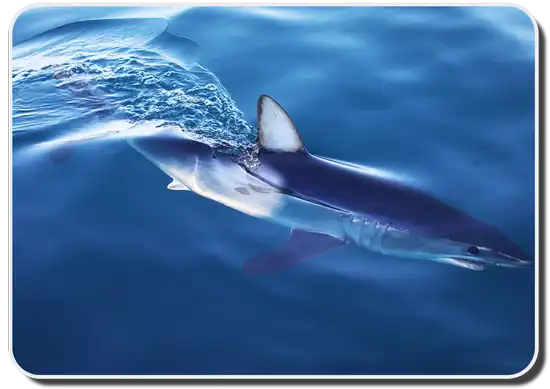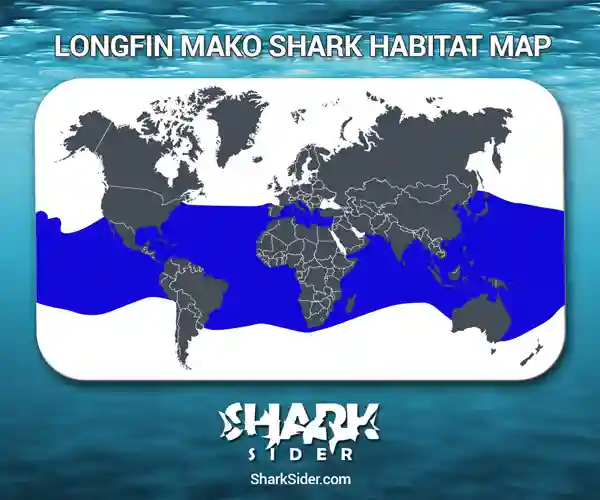The longfin mako shark is one of two species of mako shark – the other being the more common shortfin mako. It is also closely related to the great white.

Longfin Mako Shark Scientific Classification |
|
| Kingdom | Animalia |
| Phylum | Chordata |
| Class | Chondrichthyes |
| Order | Lamniformes |
| Family | Lamnidae |
| Genus | Isurus |
| Scientific Name | I. paucus |
Description
Longfin makos are about 8.2 ft long and weigh about 150 lbs. The longest specimen recorded so far is a 14 ft long female off the coast of Pompano Beach in Florida caught in 1984. They have a slim build, a pointed snout, and long gill slits.
These sharks have sharp, knife-like teeth, with 12-13 rows of teeth in the upper jaw and 11-13 in the lower one. The characteristic long fins of this mako shark that give it its name refer to the two pectoral fins larger than the shark’s head and the first dorsal fin, which is large and rounded.
They are dark grey to blue from above and white when seen ventrally.
Where do they live
Map Of The Longfin Mako Shark’s Habitat

Longfin makos are distributed globally, though whether all reported appearances are of it and not the related shortfin mako remain unconfirmed. In the Pacific, it has been spotted in Japan, northeastern Australia, southern California, Taiwan, and some islands around Micronesia. It is more widely distributed in the Atlantic, ranging from the Caribbean, the Gulf Stream, and southern Brazil in the west to the Iberian Peninsula to Ghana in the east. In the Indian Ocean, the longfin mako dwells in the Mozambique Channel.
The depths where this shark swims range from 160-720 ft judging from where the shark has been captured. This indicates that it remains in the upper mesopelagic zone most of the time, maybe returning to the esopelagic zone at night.
Behavior
Hunting
As a mako shark, it uses its excellent vision and fast movements to outpace and devour prey. Its diet mainly consists of bony fish and squid, though whether or not it feeds on swordfish similar to the shortfin mako is yet to be verified.
Migratory
These sharks are considered highly migratory, but as they are more deep-sea dwelling than their shortfin counterparts, any consistent pattern has been hard to pin down.
Speed
While not as fast as the shortfin mako, these sharks are no slouch in the speed department, swimming at blazing speeds of 35 mph.
Reproductive
They give live birth to two pups, with the unborn sharks in the womb sustaining themselves by feeding on undeveloped eggs. Research indicates that pregnant females swim into coastal waters to give birth. Initially, these sharks are 3.18–3.94 ft long and become sexually mature at 6.6 ft and 8.2 ft for males and females, respectively.
Adaptations
The streamlined build of this shark lets it swim at incredible speeds, and its large eyes give it excellent vision to locate prey quickly.
Interactions with humans
There have been no reported attacks, but due to their relatively large size, the sharks do pose a capability of hurting humans. It is often captured as bycatch alongside swordfish and tuna, and its meat is processed and sold. This has caused a decline in its numbers, with the IUCN classifying it as “Endangered” or “EN” in 2019 alongside the shortfin mako shark.
